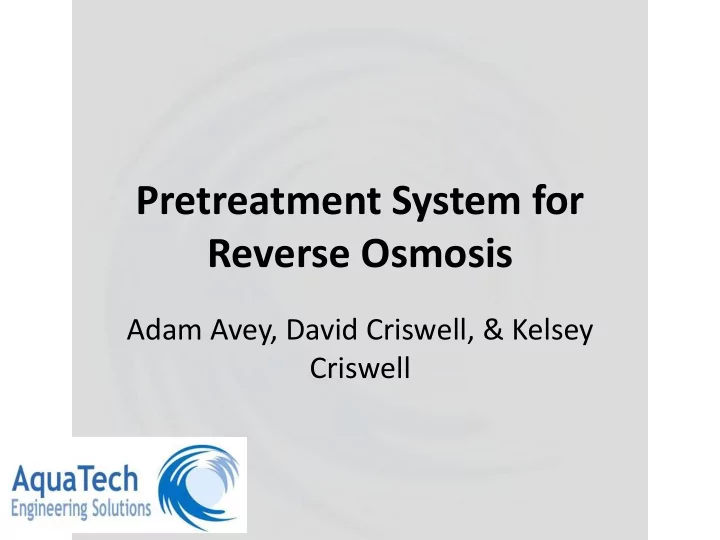

Pretreatment System for Reverse Osmosis Adam Avey, David Criswell, & Kelsey Criswell
Mission Statement “ AquaTech Engineering Solutions’ mission is to use its technical expertise and resources to provide customers with more affordable, longer lasting products.”
Problem Statement “To design and fabricate a flow -through iron removal pretreatment module for a household reverse osmosis (RO) system.”
Reverse Osmosis System
Target Group • Rural Homeowners • Small Businesses http://geology.com/articles/bottled-water.shtm
Market Analysis • Agriculture Business Teammate: Sergio Ruiz Esparza Herrera • Strategy: – Design standard prototype – Sell RO system to construction firms According to www.bccresearch.com the Reverse Osmosis industry is expected to have a compound annual growth rate of 7.3% over the next 5 years.
Chemistry • Fe(II)SO 4 + 2 OH − → Fe(OH) 2 + SO 4 2− – Need a slightly alkaline environment • Fe(II) + O 2 Fe(III) + HO - 2 − + H 2 O HO 2 + OH − O 2
Design Concept • Add oxygen to a flowing stream of water to oxidize a concentration of dissolved iron, turning it from a soluble state to an insoluble state, and then proceed to mechanically filter out the precipitate to reduce the total amount of iron in the water stream.
Original Design Concept • Eductor • Minimize power input requirement • Avoid using a holding tank • Avoid sending bubbles in RO system
Revised Design Concept • Polypropylene hydrophobic membrane • Pore size: .1 μ m
System Diagram
Equipment
Equipment • Membranes and Contactors
Experimentation 1. Maximum Membrane Differential Pressure 2. Oxygenation Rate 3. Iron Removal Rate
Methodology: Test One • Maximum Membrane Differential Pressure – Independent Variables: • Flow Rate (1 gpm) • Solution (Pure RO water) • Water Pressure (5 – 20 psi) – Dependent Variables: • Presence or absence of bubbles in membrane module
Results: Test One • Max differential pressure before bubble formation is approximately 2 psi above system water pressure.
Methodology: Test Two • Oxygenation Rate – Independent Variables: • Flow Rate (1 gpm) • Solution (Pure RO water) • Pressures (5 – 20 psi) – Dependent Variable: • Dissolved Oxygen levels
Testing Procedures 1. Measure DO in influent 2. Run system at given pressure 3. Measure DO in effluent
Test 2: Oxygenation Rate • Air valve open vs. air valve closed • t = .2569; not significantly different
Methodology: Test Three • Iron Oxidation and Removal – Independent Variables: • Iron concentrations (0.3, 0.7, 1, 3, 5 ppm) • Flow Rate (1 gpm) • Pressure (5 – 20 psi) – Dependent Variable: • Effluent Iron concentration
Testing Procedures 1. Create known soluble Iron concentration 2. Test pH level 3. Run system at given pressures 4. Measure Iron in effluent
Test 3.1: Open Tank • Test #1: – RO water, 6.3 pH • Test #2: – RO water, 6.6 pH adjusted with NaOH
Test 3.1 Results • Test #1 Initial (Fe) 5 psi 10 psi 15 psi 20 psi Ferrous Fe Concentration (ppm) 0.32 0.23 0.14 0.2 0.2 – 38% reduction • Test #2 Final Initial tank Initial (Fe) (Fe2+) 5 psi 10 psi 15 psi 20 psi (Fe) Ferrous Fe Concentration (ppm) 2.32 1.49 0.28 0 0 0 0 – 100% reduction but…
Test 3.2: pH Increase • Artificial Increase using: – NaOH – CaCO 3 • Simulate basic groundwater conditions
Test 3.2 pH Increase • Test #1 – Raise pH to 6.8 with NaOH addition – No air flow • Test #2 – Raise pH to 6.82 with CaCO 3 addition – Normal testing conditions
Test 3.2 Results • Test #1 – 24% Fe reduction Initial 0 psi 5 psi 10 psi 15psi 20psi Concentration (Fe2+) ppm 5 5 3.96 3.95 3.93 3.78 • Test #2 – 46% Fe reduction Initial 5 psi 10 psi 15 psi 20 psi Concentration (Fe2+) ppm 2.19 1.72 1.57 1.33 1.19
Test 3.3: Closed Tank • Used closed system to minimize contact with atmosphere • Simulate groundwater conditions
Test 3.3 Closed Tank • Test #1 – pH adjusted to 6.3 with NaOH • Test #2 – pH adjusted to 6.9 with NaOH • Test #3 – pH adjusted to 7.2 with NaOH
Test 3.3 Results • Test #1: 24% Fe reduction Initial 20 psi Tank (Fe 2+) Concentration (ppm) 1.43 1.08 1.42 • Test #2: 88% Fe reduction Initial 20 psi Tank (Fe 2+) Concentration (ppm) 1.3 0.16 0.5 • Test #3: 100% Fe reduction Initial 20 psi Tank (Fe 2+) Concentration (ppm) 0.51 0.0 0.58
Summary Iron Reduction Results 7.4 120% 7.2 100% 7 80% Percent Reduction 6.8 Test Water pH 6.6 60% 6.4 40% 6.2 20% 6 5.8 0% 1 2 3 4 5 6 Test Conditions at 20psi 1 No Air Addtion [6.8pH] 2 Test #1 (No pH adjust)[6.3pH] In all tests DO was increased from 3 CaCO3 Adjust #1 [6.82pH] approximately 10ppm to 14ppm 4 Bucket Test 1 [6.3pH] 5 Bucket Test 2 [6.9pH] 6 Bucket Test 3 [7.2pH]
Conclusion • System effectively removes iron • System works best with water with pH > 7.0 • Requires chemical addition for acidic water sources
Recommendations • Larger/More efficient filter • Further research on life of membranes • Further research on high flow rate systems with multiple modules
Questions?
Acknowledgements • Dr. Paul Weckler, Biosystems & Ag. Eng. • Micah Goodspeed, Pumps of Oklahoma • Dr. Glenn Brown, Biosystems & Ag. Eng. • Dr. Dan Storm, Biosystems & Ag. Eng. • Dr. Garey Fox, Biosystems & Ag. Eng. • Dr. Chad Penn, Plant & Soil Sciences • Stuart Wilson, Plant & Soil Sciences
Recommend
More recommend